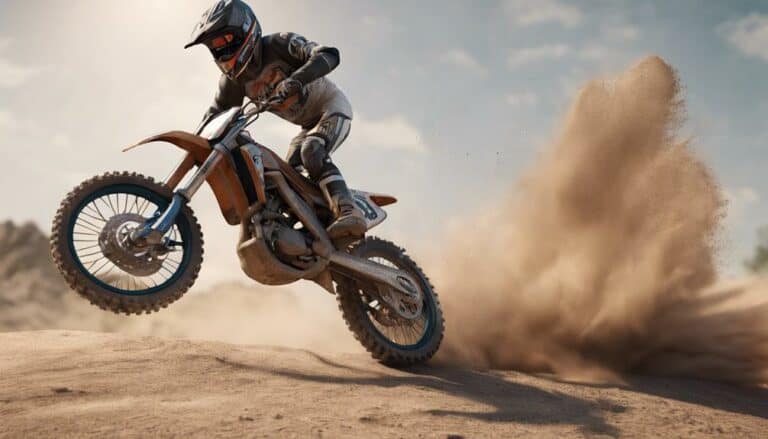You'd be surprised to know that nearly 60% of dirt bike accidents during jumps are attributed to avoidable mistakes. Ensuring a safe and successful jump involves mastering throttle control, proper balance, and precise timing.
But have you considered the impact of your body positioning and speed control? Understanding these fundamentals can make all the difference between a smooth takeoff and a rough landing.
Stay tuned to discover how avoiding some common missteps can elevate your dirt bike jumping skills to new heights.
Key Takeaways
- Maintain correct body positioning to avoid loss of control and imbalance.
- Master speed control to prevent instability and overshooting during jumps.
- Ensure proper bike setup with adjusted suspension and optimal tire pressure.
- Focus on proper landing techniques to absorb impact and maintain post-jump stability.
Improper Body Positioning
Avoid common mistakes when learning to jump a dirt bike by mastering proper body positioning. Improper body positioning, such as leaning too far back or forward, can lead to a loss of control during jumps.
To maintain balance, make sure you aren't clamping onto the bike but rather matching your body movement with power delivery. Leaning into the jump face is important as it helps counteract the incline and promotes better control in the air.
Weight imbalance resulting from incorrect body positioning can lead to looping out or endowing forward, greatly increasing the risk of accidents. Proper balance through correct body positioning is essential for safe and controlled jumps on a dirt bike.
Inadequate Speed Control
Improper speed control while jumping a dirt bike can dramatically impact your performance and safety on the track. To avoid common mistakes, focus on maintaining the right speed throughout the jump. When approaching the ramp, make sure you squeeze the bike with your legs and keep the throttle right to maintain a steady pace. It's essential to adjust your speed based on the jump's distance and height to avoid overshooting or coming up short. If you hit the jump at high speed, the bike may get a little bit sideways, causing instability in the air. Remember, the four-stroke power curve can be unforgiving if you don't manage your speed effectively.
During the jump, make sure the bike tracks straight by squeezing and taking the hit with your legs. Improper throttle control can result in loss of control mid-air, leading to a rough landing. By mastering speed control, you enhance your ability to tackle jumps smoothly and with confidence.
Lack of Proper Bike Setup
When setting up your dirt bike for jumping, ensuring the proper adjustment of suspension sag, rebound, and compression is essential for optimizing your performance in the air. Improper balance of your suspension settings can lead to issues like bottoming out or unpredictable kicks mid-air, affecting your control and stability. Additionally, maintaining the correct tire pressure, handlebar position, and footpeg height are important for achieving the right balance position during high jumps.
Neglecting factors such as chain tension and sprocket alignment can result in power loss or even chain derailment while in mid-air, causing potential accidents. It's important to keep up with regular maintenance tasks like checking brakes, throttle, and cables to prevent unexpected failures during jumps. By paying attention to these details in your bike setup, you not only enhance your jumping performance but also ensure a safer and more enjoyable experience on the dirt track.
Neglecting Landing Techniques
Setting up your dirt bike for jumping is just the first step; neglecting proper landing techniques can greatly impact your control and stability post-jump. When you land after a jump, absorbing the landing impact through your legs and the bike suspension is essential. This technique helps you maintain control over the bike and guarantees a smoother landing.
If you find your bike landing slightly sideways, landing on the gas can assist in straightening it out, giving you better control. Proper landing technique is vital to prevent any loss of control and maintain stability after landing.
Skipping Basic Jumping Practice
To build a solid foundation for your dirt bike jumping skills, starting with basic jumping practice is essential. Skipping this important step can result in inadequate skills and greatly increase the risk of accidents.
It's important to begin by practicing on smaller jumps to build confidence before progressing to larger ones. Ignoring foundational techniques such as throttle control and body positioning can hinder your jump progression and put you at a higher risk of injury.
Consistent practice on basic jump techniques is key to developing muscle memory and reflexes necessary for successful jumps.
Conclusion
As you continue to master the art of jumping a dirt bike, remember to avoid common mistakes like improper body positioning and neglecting landing techniques.
Just like a skilled acrobat on a tightrope, finding the perfect balance between throttle control and body movement is essential for a successful jump.
So, keep practicing, stay focused, and soon you'll be soaring through the air with confidence and control. Happy jumping!

